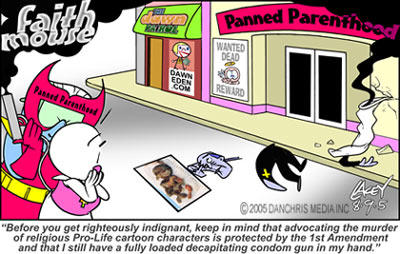Months ago, when I was fighting for Terri, I blogged an article that mentioned the drugging of Kids at an Orphange run by a Catholic charity and in conjunction with Columbia Presbertyrian Hospital in NYC. (
That Article Here- Halfway through is the mention of human experiments and the kids kidnapped for such a purpose!)
As more is uncovered and Debated over the morals of such a crime one worker has stepped up to the plate to describe what she , witnessed, and took part in.
Mimi Pascual gave the children drugs every day and every night, on schedule, as the doctors ordered. She shook the children awake and popped the pills into their mouths, or squirted a syringe full of ground pill and water to the back of their throats.
She and the other child-care workers made the rounds: midnight, 3 a.m., 5 a.m. Some kids took the pills by mouth, some through nasal tubes, and some through tubes jutting out of their stomachs. The children didn't like the drugs. They'd wake up vomiting or with bad diarrhea. But Mimi and the workers at Incarnation Children's Center had to follow the regimen, or they'd be fired."The drugs had side effects, everybody knew that," said Mimi. But the workers were told the drugs were saving the children's lives. After a young girl who had just gone on the drugs had a stroke and then quickly died, and another young boy who was put on thalidomide wasted away on a respirator, Mimi stopped believing that the drugs were just saving lives. She believed they were killing the children too. ....
Hired as a child-care worker, she soon found herself a surrogate mother to the children, changing them, feeding them, holding and hugging them—and drugging them.
"At first they were little babies," Mimi told me. "We changed their diapers and cleaned them up, and played with them. We were told they were 'special'—because of the HIV......
Besides feeding, changing and bathing duties, the child-care workers were also responsible for administering drugs to the infants.
"The nurses would lay out the drugs on the counter. Lots of pills, powders and oral syringes, all labeled for each particular child. We'd pick up the syringe and put it right into the mouth or into the tube if they had one.
"We didn't like it, but that was our job," said Mimi. "We were told that they would die without the drugs—and since we were with the kids the most, it was up to us."
"But over time," Mimi said, "we began to feel betrayed."
"In the beginning we were taking care of little abandoned crack babies who had no one, but then it changed. More and more of the kids were there for compliance. They didn't want to take drugs, or their parents didn't want to give them, so they got put in ICC. ...
(Some of these kids were taken by Social Services, and put in there for the reason of needing more bodies to experiment on.)
"We figured it out," she said. "These were experimental treatments." Marta, another child-care worker, put it more bluntly, "This is the guinea-pig business," she said.....
ICC is administered by Columbia Presbyterian Hospital and the Catholic Home Bureau. It was under ICC's first medical director, Dr. Stephen Nicholas, that the orphanage began to receive funds from the National Institutes of Health to use its wards in pharmaceutical clinical trials.....
(The NIH is the FEDERAL GOV'T's OWN OFFICE! They Approve use of Kids for Experiments!)
ICC claims to have stopped the trials in 2002, but children from ICC are still seen at major New York hospitals, including Columbia Presbyterian, which all continue to do trials with HIV-positive children.
In 2005, following a year of media coverage on ICC, the New York City Council held a City Hall meeting to determine what exactly had happened there. Mimi attended.
"What a joke," she said. "They were trying to find out if ICC was doing trials… We were giving kids experimental drugs since the beginning. It was no secret. If you asked the nurses about it, you were told it was normal, and not to ask questions. If you asked the doctors why some kids got AZT and some didn't, you didn't get an answer."
"But we knew drug trials were going on," said Mimi. "The child-care workers, the nurses, the doctors, administration—everybody knew.".....
We were always told that without the meds they would die," said Mimi.
"Is that what happened?" I asked.
"No," said Mimi. "It wasn't that predictable. Some kids lived and some kids died. But the ones who were drugged the most did worse." She added, "The ones with the tubes always did worse."
When Mimi started at ICC, the tubes were used infrequently. "But when the kids got older, a lot of them started to refuse the medication," she recalled. "Then they started coming in with the tubes more and more."
"Kids who refused too much, or threw up too much, they'd get a tube. First it was through the nose.
"But then it was more and more through the stomach. You'd see a certain child refusing over and over, and one day they'd come back from the hospital from surgery, and they had a tube coming right out of their stomach.
"If you asked why, the doctors said it was for 'compliance'—the regimen. Got to keep up the regimen," said Mimi. "Those were the rules.".....
"One girl, a six-year-old, Shyanne—she came in for adherence. She was the most delicate little flower—beautiful, polite, full of life. Her family never gave her meds. So Administration for Children's Services brought her into ICC."
"So, she came in, and started the meds. And it was three months, maybe three months. And she had a stroke. She couldn't see. She was this normal girl, singing, jumping, playing. Then, poof, stroked out. Blind. We were freaked out. Then, in a few months, she was gone—dead."
OH MY GOD! I AM GETTING PICTURES OF NAZI GERMANY HERE. PARENTS WHO REFUSE TO EXPERIMENT WITH THEIR KIDS GET THEM TAKEN AWAY. THE KIDS GET PUT IN A HOSPITAL WHERE TUBES ARE INSERTED INTO THEM SO THEY WILL "COMPLY WITH TAKING THE MEDS!I SPEAK CURSES ON THOSE DOCTORS, THE GOV'T THE SOCIAL WORKERS, THE NUNS, EVERYONE INVOLVED IN THIS. I CURSE THEM AND THEIR GENERATIONS, MAY GOD PUNISH YOU SO SEVERELY, THAT MERCY ISN'T EVEN ENOUGH FOR YOU PEOPLE!Shawn is also in ICC because he doesn't like to take the drugs, and Mona, his aunt and legal guardian, doesn't like to give him drugs that she claims make him weak and sick.
Shawn acts out—he runs away whenever he can to get away from the constant, monitored drugging. When he is returned to ICC, Shawn tells me, it's "needle time"—time for Thorazine shots, then off to a local psych ward.
"They're destroying him," his aunt Mona tells me. "He just wants to come home, it's so obvious. That's why he runs away."
"The regime has changed," said Mimi, "and so has the place. It's AIDS drugs plus—plus psych meds, anti-psychotics, antidepressants.
ALL YOU PARENTS OUT THERE WHO HAVE YOUR KIDS ON ANTI-DEPRESSANTS, AND OTHER PSYCHE DRUGS, YOU ARE NOTHING BUT PAWNS IN THE GOV'TS GAME OF EXPERIMENTAL TREATMENTS!Now these experiments are going on elsewhere!
ICC's founding physician, Dr. Steven Nicholas, moved on to head Harlem Hospital's Pediatric division in 2001. Nicholas is also project leader and principal investigator for two ongoing HIV/AIDS projects in La Romana, Dominican Republic. Like ICC, these projects are funded and overseen by Columbia University in conjunction with the local church and state authorities.
Instant Karma At ICC?
Rhonda, a former nurse from ICC, relates the story of how Marylin Santiago, one of ICC's supervising nurses, suffered a needle-prick injury, and went on AZT, according to the current recommendation for healthcare workers.
"She was not well at all," said Rhonda, "Malaise, diarrhea, she was tired out, like she was going to die."
Mimi added, "She had it bad. She got a dose of her own medicine."
Rhonda pointed out that when Santiago got off the AZT, her system returned to normal.
AZT, the drug that is used in case of needle-stick injuries, is the same drug given to pregnant women and young children who test HIV positive worldwide. It was also used the ICC trials. AZT is often referred to in the mainstream press as a "life-saving" drug, despite the fact that it warns of the possibility of fatal anemia and organ failure on its label. A 1999 study in the journal AIDS reported that children born to mothers who are given AZT are sicker and die faster than those not given the drug. It is one of several recent studies reporting that AZT increases the rate of illness, major malformation and death in children whose mothers are fed the drug.
Mimi described a boy named Seon, who died in spring of 2004.
"He had all these soft, fatty lumps. We even called him "lumpy." She said. They sent him to get the lumps on his neck removed in surgery, and they would just grow back. They told us it was cancer, but he was on all those drugs. He had a tube, and they were always pumping him. When we changed his diapers, it would come out like the drug mixture—rough and sandy like the ground-up pills."
Mimi said that after he died, she read about the phenomenon of "buffalo humps," large fatty lumps on the back and neck that result from the newer AIDS drugs called protease inhibitors.
Rhonda, the former ICC nurse, and Mimi both remember another boy at ICC who developed a breast while on the drugs. "He had a mastectomy, and then the other one started to grow. They couldn't hide that it was because of the drugs, but with Seon, they told us it was cancer," said Mimi.
Mimi has a paper from ICC, that she saved from Seon's treatment. "One day I got a sheet from the nurses about a drug they were going to give Seon—it said any woman who was pregnant or who was of child-bearing age should not touch the drug, even with gloves on."
"I couldn't pronounce the name, so I kept the sheet. Thalidomide. That's what they gave him."
Thalidomide was originally marketed as a safe, over-the-counter sedative and analgesic in the 1950s and 1960s throughout Europe. It caused a wave of severe deformities in children of pregnant women who took the drug and was taken off the market. In 1998, the drug company Celgene resurrected Thalidomide, with FDA approval, officially as a leprosy drug, but with intended off-label use for AIDS and cancer patients.
"They pumped Seon with it; he deteriorated fast," Mimi said. "Once day we came in and he was bleeding from every hole in his body—his rectum, his nose, his mouth. He was in such pain. He would scream when he had to go to the bathroom. They put him on a respirator. They induced a coma with drugs so they could put him on a respirator. They told us they did it so he could breathe better." Mimi said, her voice getting a little rough. "I sat with him; he couldn't talk, but he was crying-tearing from his eyes. "He got all dry and scaly; he shriveled up like a snail-and he died.".....
READ THIS!



































